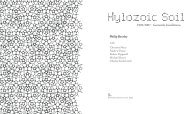The Inner Studio - Riverside Architectural Press
The Inner Studio - Riverside Architectural Press
The Inner Studio - Riverside Architectural Press
You also want an ePaper? Increase the reach of your titles
YUMPU automatically turns print PDFs into web optimized ePapers that Google loves.
PART THREE | INNER RESOURCES<br />
repress and project onto others. This act of repressing takes considerable<br />
energy to maintain, as does the act of sustaining a<br />
judgmental projection. Not only is this energy lost to us, it prevents<br />
us from having compassion for anyone–including ourselves.<br />
This need to assimilate our shadow aspect is easy to write<br />
about, but is difficult to achieve. It is difficult because it means<br />
accepting longstanding parts of ourselves that have been labeled<br />
unacceptable. <strong>The</strong> value of the shadow to the designer is that it<br />
often presents us with new ways to understand our problems. For<br />
example, when we draw a building two-dimensionally, there is no<br />
shadow. <strong>The</strong> building exists only as a façade. Not until we incorporate<br />
the shadow does the building become three-dimensional<br />
and gain depth. In other words, incorporating the dark shadow can<br />
often bring the quality of transformation to our work in the form<br />
of new images and ideas.<br />
<strong>The</strong> shadow is within us, but because we don’t search for it<br />
there, our only choice is to project it out onto others or into the<br />
world and build it. Because the shadow belongs to individuals, it<br />
can manifest itself in all things that are created by individuals. It is<br />
found in collective entities like business organizations, institutions,<br />
and governments. <strong>The</strong> shadow of society is a massive force, an<br />
accumulation of unconscious aspects projected onto others, onto<br />
our cities, and onto the way we treat the natural world. It is found<br />
in our institutions, in our public spaces, and in our homes. In a<br />
sense, everything created contains the unconscious imprint of its<br />
makers and carries their shadows. In an individual, this may<br />
appear as a sudden stream of judgment; in society, it manifests<br />
when those in positions of power collectively refuse to acknowledge<br />
vast depressing stretches of city because of the unconscious<br />
judgments they project onto those places and the people who live<br />
there. <strong>The</strong> contemporary trend to “heal” toxic sites, be they residential<br />
or industrial, represent positive examples of reclaiming the<br />
collective civic shadow.<br />
One example of shadow that has been assimilated into the built<br />
world over the last 30 years is interesting because it may herald a<br />
shift of awareness as profound as any of the great technological<br />
inventions of the past. Since the 1970s, for the first time, building<br />
95





